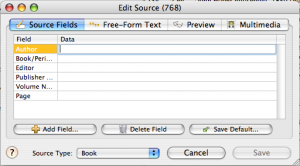Adding Sources in Reunion

Adding source information in Reunion for Mac is a straightforward process. Adding source information efficiently can be a little more tricky. This post shows how I’ve approached the problem.
There are two methods to input source data in Reunion.
Source Fields
When you want to add a source, you can select a source from the “Add Sources” menu on the person or source window. Selecting a source type will open a window with a selection of predetermined fields to fill out.
You can fill in your source information using these fields, or change the fields by either adding or deleting fields. You can also change the source type from this window. If you enter your information this way, your source will look something like this:
27. Ashby, Bernice M., Shenandoah County, Virginia Marriage Bonds, 1772-1850, Virginia Book Company, Berryville, VA, 1967, 170.
Free-Form Text
Alternatively, you can choose to enter your source information as “free-form” text. This is the solution I’ve chosen, primarily because I want my source citations to conform to accepted standards. Using this method, the same source (as above) would look like:
27. Ashby, Bernice M., Shenandoah County, Virginia Marriage Bonds, 1772-1850 (Virginia Book Company, Berryville, VA, 1967), page 170.
In both of these examples, I’ve included the page number as part of the post. That’s fine if you only need to reference one page in this book. But what if you want to cite multiple pages for for different people or events? Using this method, you’ll wind up adding this book to your source list multiple times. Not very efficient.
Detail Field
A good way around this is to make use of the “Detail” field associated with each source citation. In this case, I did not add the page number to the source, but instead added it to the source citation detail field as shown.
When you create a report and include sources, the source will be listed as in the free-form text example, including the page number. But you’ll be able to reuse source #27 for multiple citations with differing page numbers. This will save you time and effort in entering source data.
Much more efficient.
If you need more information on how to use the source citation detail field to capture information, please take a look at the Recording Source Detail in Reunion for Mac video on GenealogyTools.com. While we differ in our use of “Source Fields” vs. “Free-Form Text” and in the data we capture in the “Source Citation Detail” field, this video will give you a step-by-step tutorial on how to use the application.
 For a great book on citations and analysis for family genealogists, please see Evidence! Citation & Analysis for the Family Historian
For a great book on citations and analysis for family genealogists, please see Evidence! Citation & Analysis for the Family Historian.
Cite This Page:
Kris Hocker, "Adding Sources in Reunion," A Pennsylvania Dutch Genealogy, the genealogy & family research site of Kris Hocker, modified 17 Sep 2010 (https://www.krishocker.com/adding-sources-in-reunion/ : accessed 25 Apr 2025).
Content copyright © 2010 Kris Hocker. Please do not copy without prior permission, attribution, and link back to this page.



